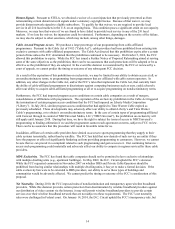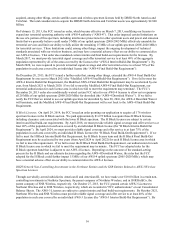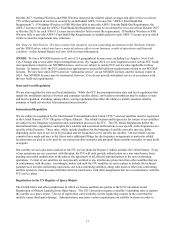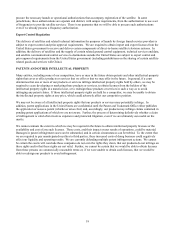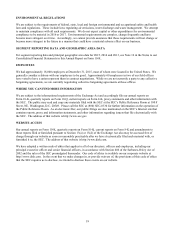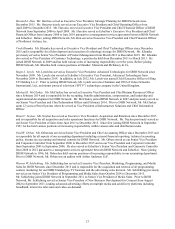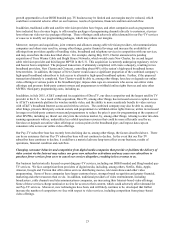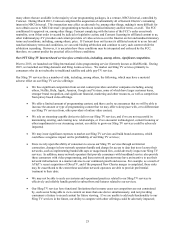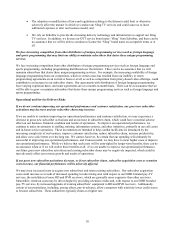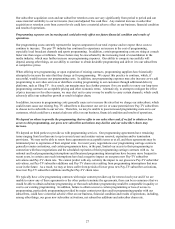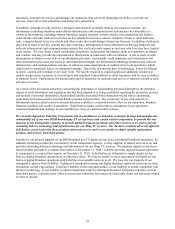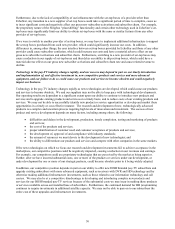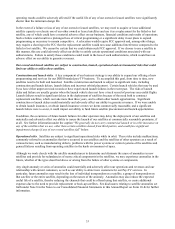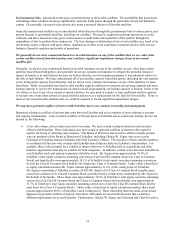Dish Network 2015 Annual Report Download - page 34
Download and view the complete annual report
Please find page 34 of the 2015 Dish Network annual report below. You can navigate through the pages in the report by either clicking on the pages listed below, or by using the keyword search tool below to find specific information within the annual report.24
These products and services are also driving rapid changes in consumer behavior as consumers seek more control over
when, where and how they consume content and access communications services. In particular, with the large increase
in the number of consumers with broadband service, a significant amount of video content has become available through
online content providers for users to stream and view on their personal computers, televisions and other devices.
Similarly, consumers have increased access to video content via mobile devices. These technological advancements and
changes in consumer behavior with regard to the means by which consumers obtain video content may cause DISH
subscribers to disconnect our services (“cord cutting”), downgrade to smaller, less expensive programming packages
(“cord shaving”) or elect to purchase through online content providers a certain portion of the services that they would
have historically purchased from us, such as pay per view movies, resulting in less revenue to us. There can be no
assurance that our Pay-TV services will be able to compete with these other providers of digital media. Therefore, these
technological advancements and changes in consumer behavior could reduce our gross new subscriber activations and
could have a material adverse effect on our business, results of operations and financial condition or otherwise disrupt
our business.
Our failure to effectively anticipate or adapt to competition or changes in consumer behavior, including with respect to
younger consumers, could have a material adverse effect on our business, results of operations and financial condition or
otherwise disrupt our business.
Economic weakness and uncertainty may adversely affect our ability to grow or maintain our business.
A substantial majority of our revenue comes from residential customers whose spending patterns may be affected by
economic weakness and uncertainty. Our ability to grow or maintain our business may be adversely affected by
economic weakness and uncertainty and other factors that may adversely affect the pay-TV industry. In particular,
economic weakness and uncertainty could result in the following:
x Fewer gross new subscriber activations and increased subscriber churn. We could face fewer gross new
subscriber activations and increased subscriber churn due to, among other things: (i) certain economic factors
that impact consumers, including, among others, rising interest rates, a potential downturn in the housing
market in the United States (including a decline in housing starts) and higher unemployment, which could lead
to a lack of consumer confidence and lower discretionary spending; (ii) increased price competition for our
products and services; and (iii) the potential loss of independent retailers, who generate a significant percentage
of our new subscribers, because many of them are small businesses that are more susceptible to the negative
effects of economic weakness. In particular, subscriber churn may increase with respect to subscribers who
purchase our lower tier programming packages and who may be more sensitive to economic weakness,
including, among others, our pay-in-advance subscribers.
x Lower pay-TV average monthly revenue per subscriber (“Pay-TV ARPU”). Our subscribers may disconnect
our services and a growing share of pay-TV customers are “cord shaving” to downgrade to smaller, less
expensive programming packages or electing to purchase through online content providers a certain portion of
the services that they would have historically purchased from us, such as pay per view movies. Cord cutting
and/or cord shaving by our subscribers could negatively impact our Pay-TV ARPU.
x Higher subscriber acquisition and retention costs. Our profits may be adversely affected by increased
subscriber acquisition and retention costs necessary to attract and retain subscribers during a period of economic
weakness.
Our competitors may be able to leverage their relationships with programmers to reduce their programming costs and
offer exclusive content that will place them at a competitive advantage to us.
The cost of programming represents the largest percentage of our overall costs. Certain of our competitors own directly
or are affiliated with companies that own programming content that may enable them to obtain lower programming costs
or offer exclusive programming that may be attractive to prospective subscribers. Unlike our larger cable and satellite
competitors, some of which also provide IPTV services, we have not made significant investments in programming
providers. For example, in January 2011, the FCC and the Department of Justice approved a transaction between
Comcast and General Electric pursuant to which they joined their programming properties, including NBC, Bravo and


